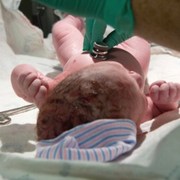 Photo: Getty Images
Photo: Getty Images
Parents bringing home a new baby have lots to think about. Between diapering, feeding, and quieting the various cries, one other concern is often taking care of the umbilical cord stump. This stump is leftover after the doctors clamp and cut the umbilical cord at birth.
The umbilical cord is essential to a baby's development while in the womb.
It connects the placenta to the baby's abdomen and provides the needed nourishment and oxygen throughout the prenatal development process. It also carries waste from the baby out to the mother's blood stream and is eliminated by her kidneys.
Once the child is born, the umbilical cord is no longer needed so it is cut close to the baby and will eventually fall off, leaving behind just a cute little belly button.
A newborn typically retains the umbilical cord stump for 10 to 21 days. When it falls off it may leave an open wound (similar to a scab coming off) and will need to be cared for accordingly.
There may be a small amount of blood detected in the area when the stump does fall off, which is perfectly normal. Parents should not pull the stamp off, even if it looks to be hanging by a thread. It will fall off eventually when the time is right.
Parents should also refrain from giving the child tub baths until the stump falls off. Sponge baths work perfectly well until that point.
Prior to the stump falling off, the area will need to be kept clean and dry. Today newborn diapers often have a cut-out to account for the umbilical cord stump, but if not, then the diaper can be folded over in front so as not to aggravate the area.
Urine should not come in contact with the umbilical cord area but it can, and should, be exposed to air. Avoiding bodysuit-style undershirts that snap together can be helpful. In warm weather, a simple T-shirt and a diaper should suffice until the stump falls off.
In the past, parents were expected to clean the area with cotton swabs or gauze and rubbing alcohol one or two times a day. While there are pediatricians who still subscribe to this process, most now advise parents to leave the area alone so it can dry quicker and heal faster.
With so many things to remember when caring for a newborn, it is helpful that this aspect is pretty straight forward.
Sources:
MarchofDimes.com. Web. 8 February 2012. "Complications of the umbilical cord."
http://www.marchofdimes.com/pregnancy/complications_umbilical.html
Babycenter.com. Web. 8 February 2012. "Caring for your newborn's umbilical cord stump."
http://www.babycenter.com/0_caring-for-your-newborns-umbilical-cord-stump_127.bc
Reviewed February 9, 2012
by Michele Blacksberg RN
Edited by Jody Smith





Add a CommentComments
There are no comments yet. Be the first one and get the conversation started!